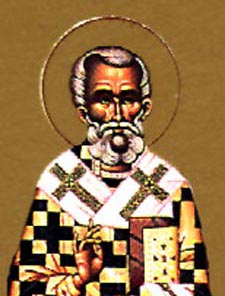Feast Day ~ April 8
 At many points in the history of the Church, Christians have been accused of being merely against things. “Thou shalt nots” appear to take precedence over “Thou shalts”. What we believe is wrong seems to be emphasized over what we believe is right. This accusation could certainly be made against Pope St. Celestine I, whose pontificate lasted from 422 to 432.
At many points in the history of the Church, Christians have been accused of being merely against things. “Thou shalt nots” appear to take precedence over “Thou shalts”. What we believe is wrong seems to be emphasized over what we believe is right. This accusation could certainly be made against Pope St. Celestine I, whose pontificate lasted from 422 to 432.
Very little is known of Celestine’s early life except that he was a Roman from the region of Campania. He is known to have lived in Milan (perhaps as a student) when St. Ambrose was the bishop of that city. He is mentioned as a deacon in a document by Pope Innocent I in the year 416. Evidence in his writings suggest that he had received an excellent education. When Pope St. Boniface died in the year 422, Celestine was selected to succeed him.
After the terrible persecutions of the early centuries of the Church, which produced so many martyrs and confessors, Christians had enjoyed the peace and safety of a legal and favored religion since the reign of Constantine I. But the dangers came from within now, and with each wave of controversy regarding theological innovation, that peace and safety were threatened. Pope Celestine had to deal with three of these controversies.
One of the heresies that had persisted for several centuries was that of Novatianism (begun during the persecutions of Emperor Decius) – the stance that forgiveness for apostasy could not be given by the Church, no matter the sincerity of the penitent. Even though this controversy had been settled by the excommunication of Novatian, adherents of this rigid approach remained active, with congregations occupying churches under the jurisdiction of the pope in Celestine’s time. The pope removed the Novatian priests and their followers from church buildings and, as attested in a letter of St. Vincent of Lerins in 434, wrote to the clergy in Gaul that by their silence on this issue, they were acquiescent in the error.
Further afield, Pope Celestine had to deal with a controversy among the Christians in Britain. There, the priest Pelagius taught that man, through his free will, had the power to achieve salvation without direct aid from God. Pelagius died in the year 418, but his heresy outlived him and Celestine was compelled to send Germannus, the bishop of Auxerre in Gaul, to Britain to combat this false teaching. (St. Bede tells a wonderful story of St. Germannus’ time in Britain when he aided in the winning of a battle through the shout of the Paschal “Alleluia!”) Urging the Pope to send Germannus was the presbyter Palladius, who was soon sent by the pope to be the first bishop of Ireland. St. Patrick may also have been sent by Pope Celestine.
In his ten-year pontificate, Pope Celestine had yet another heresy to combat – that of Nestorius, the Bishop of Constantinople who taught that Christ was two persons – one divine and one human. This controversy raged primarily in the Eastern part of the Empire, but St. Celestine, as an ardent protector of Orthodox Christianity sent representatives to the First Council of Ephesus (the Third Ecumenical Council) in 431 to support the teaching of the Apostles. He also wrote letters to bishops in Africa, Gaul, and the East in support of the Orthodox position.
St. Celestine passed from this life to the next in 432 and his body was buried in the cemetery of St. Priscilla in Rome. His relics were later translated to the basilica of St. Prassede.
Was St. Celestine a “nay-sayer”? Did he just represent a negative religion which is against many ideas? The fathers of the Church teach us that vigilance is essential for combating the evil and sin that exist in this world. We have been entrusted with the Truth of God – Father, Son, and Holy Spirit – and we must guard this Truth against all efforts to pervert it, to water it down, to make it more palatable for the people of today. We must remember St. Celestine’s admonition that, when Truth is thwarted, by our silence we consent to the sin. May St. Celestine pray for us as we face mighty challenges to the Orthodox understanding of Christian teaching.